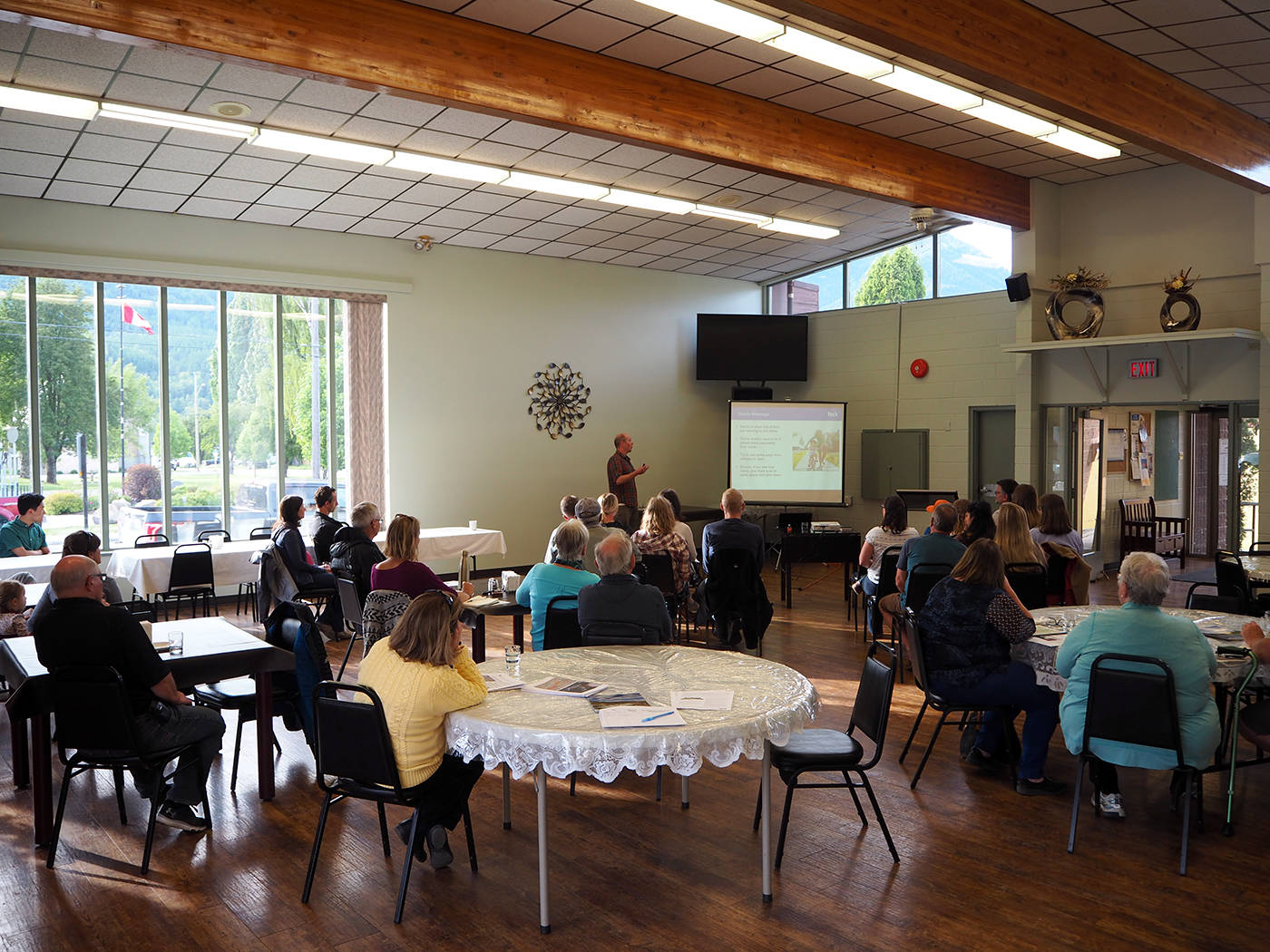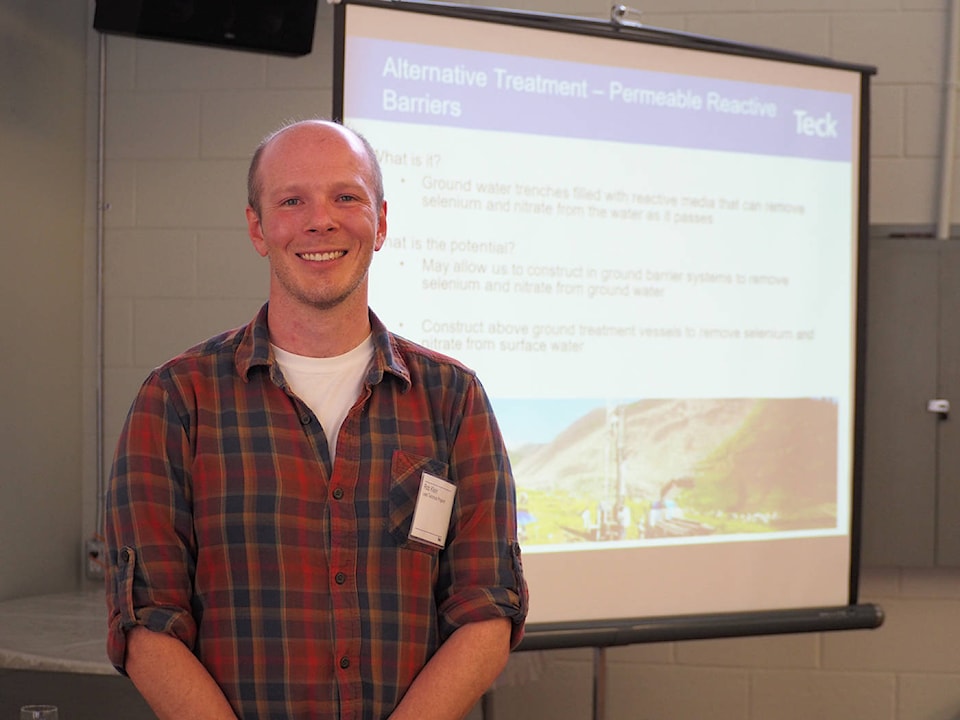Giant “bathtubs” containing microbes that naturally remove selenium and nitrate from mine-affected water could be the answer to Teck’s water quality woes.
Saturated rock fills are one of two alternative water treatment technologies being investigated by the mining company’s research and development team, and a trial at Elkview Operations in Sparwood has proven successful so far.
R&D Technical Program Lead Rob Klein presented his team’s findings to about 35 people gathered at the Fernie Senior Citizens Drop-In Centre last Tuesday, June 12, for the first in a series of information sessions on water quality.
Klein explained Teck’s R&D program was split into three areas: knowledge building, source control and alternative treatments.
Knowledge building focuses on the fundamental science behind compounds of interest, such as selenium, a naturally-occurring element that is essential to humans and animals, but in high concentrations can impact ecosystems.
“That’s really important for us to understand, so that we can be better at predicting what we think will happen, as well as helping us to understand which technologies will be the most effective for the different compounds of interest,” said Klein.
Source control methods being investigated by Teck are low oxygen zones and covers, whereby scientists try to prevent selenium and other compounds being exposed to oxygen and escaping from waste rock into waterways.
Saturated rock fills and permeable reactive barriers are “passive” technologies that could be used to treat mine-affected water.
Klein said permeable reactive barriers were essentially trenches lined with materials that absorbed compounds of concern, while a saturated rock fill could be described as a “big bathtub”.
“What we see in our research is that these bathtubs, they’ve got microbes in them that… will remove both selenium and nitrate from the water,” he said.
“What we want to try to start doing is taking water that has elevated levels of these things, inject it into the pit, leave it long enough for those to come out, and then return it to the receiving environment.
“The potential here is that these are really, really big fills, for example, the one at Elkview holds over six million cubic metres of water.
“What these will allow us to do is to treat large volumes of water that doesn’t require big active treatment plants, so we’re not building tanks, we’re not heating water… it all happens inside this one big pit.”
Teck has been investigating saturated rock fills since 2010 and after a successful purpose built trial in 2016, constructed a full scale application at Elkview.
The 1km by 1km pit can hold six million cubic metres of water and is fed by a 3.5km pipeline.
Klein said mine-affected water was injected into the pit and passed through a series of walls before being pumped into a buffering pond.
Once selenium and nitrate are deemed at safe levels, the treated water is released into the environment.
“We’re seeing very strong removal of both selenium and nitrate by the time the water gets to the first row (of walls),” he said.
“The next step for this is to keep working on the technology to understand all the remaining questions we have. We want to make sure that we understand what are the risks of using this in the long term.”
It took more than 17 months to build the full scale application at Elkview, which came at a cost of $40 million.
But this is a fraction of the time that it takes to construct an active water treatment facility, according to Klein. The trial could soon be duplicated at Teck’s other mines.
“The other thing we’re doing is going back to all the mines around the Valley looking at where do we have opportunities to deploy this technology because we’ve shown that we can do it relatively quickly, so if there are other places we can use it, let’s start using it,” he said.
Last month, Teck announced work had begun on an active water treatment facility at Fording River Operations north of Elkford.
Over the next five years, the mining company expects to invest between $850 and $900 million on the construction of water treatment facilities as part of its commitment to the Elk Valley Water Quality Plan.
Klein explained the difference between active and passive water treatment.
“Active treatment, where we’re building a big building, we’re heating the water, we’re pumping water through tanks, that’s the definition of active treatment,” he said.
“Passive treatment would be the water naturally comes out of the spoil, runs into some type of system where it’s treated and naturally filtered. There’s no human interaction, it just takes care of itself.”
Klein said Teck would transition to passive treatment technologies once they were proven effective and safe.
“We are actively building treatment plants to make sure that we are meeting our commitments to maintain water quality,” he said.
“But as these new research technologies come online and they’re proven, we want to deploy them as quickly as possible, so that we can either not build more treatment plants or we can shut treatment plants down.”
Ultimately, Teck hopes to find a low-maintenance technology that will prevent harmful amounts of selenium and nitrate reaching local waterways for years to come.
“To me, the work is so important because we don’t want to have treatment plants across the Valley that we’re running for a long period of time,” said Klein.
“We want to be transitioning to technologies that we don’t have to have people running them, we can actually walk away from them and not be treating water flow for a long time.”
Next talk to focus on aquatic health
Teck staff have fielded questions about water quality targets, airborne dust and traffic management at a public meeting inFernie.
About 35 people, including Teck staff, gathered at the Fernie Senior Citizens Drop-In Centre last Tuesday, June 12, for thefirst in a series of information sessions on water quality hosted by the mining company.
“It’s just an opportunity to answer as many questions in the community as we can,” said Teck’s Manager of SocialResponsibility, Nic Milligan.
“We’re trying to do a couple of focused sessions on topics where we feel we get questions consistently.
“(It) provides an opportunity to provide focused information to the people who are interested in it.”
The first session focused on Teck’s research and development program and was presented by R&D Technical Program LeadRob Klein.
At the end of the two-hour presentation, audience members were given a chance to ask questions.
These ranged from how Teck planned to meet targets set under the Elk Valley Water Quality Plan to airborne dust and trafficmanagement near coal mines, which staff did their best to answer.
Prior to Tuesday’s meeting, Teck announced it would make water quality reports and data publicly available to increase publicknowledge and encourage innovation.
Milligan said the next session would be on aquatic health and water quality with a date to be announced soon.
“It’s part of our plan to consistently be more transparent around water quality and our efforts to improve water quality, andour commitment to water quality in the Elk Valley,” he said.

